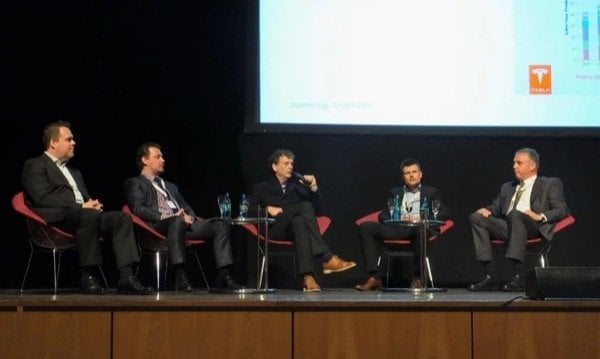Successful 10th Battery Experts Forum
An even more comprehensive program impressed the participants of the 10th Battery Experts Forum – formerly called "Development Forum Accumulator Technologies"
An even more comprehensive program impressed the participants of the 10th Battery Experts Forum – formerly called "Development Forum Accumulator Technologies" – organized by Batteryuniversity in Aschaffenburg, Germany, from 5 through 7 April 2016. More than 40 top-class speakers informed around 600 experts about state-of-the-art technology trends, who attended to discover trends and to find solutions.
For the first time, the congress with accompanying exhibition (40 companies) successfully organized five additional parallel sessions, too – all of them totally sold out. And also booked to the last seat with 120 participants was the preceding Training Day on Tuesday, 4 April, with fundamental courses in German and in English on battery technologies, management, safety and chargers.
After the welcoming address by Dr. Jochen Maehliss of Batteryuniversity the most interesting paper of the first forum day was the profound and in-depth keynote "The world market 2016" held by Sven Bauer, CEO of BMZ – The Innovation Group, in strong words within parts amazing findings and open-hearted comments. Following actual data and trends, he sees the year 2020 as the breakpoint for a new market structure.
Presently he confronts the fact, that 90% of the existing worldwide market (around 425,000 MWh) is lead acid with the discussions in the European Union to ban lead, which is no longer state of the art and is number one in the failure rate. NiCd batteries are almost out, NiMH still shows some growth, but everything points in the direction of Li-ion. Other solutions like flow batteries or NAS. In Y20 the total battery capacity will reach 221 GWh while lithium batteries (LIB) take 80 GWh – their penetration is then especially expanded in the motive sector (2 million e-bikes sold last year, or golf cars) – it´s then almost doubled (from 33 to 63%), in tools (from 23 to 33%) and in storage (59 to 68%). In the SLI application (Start, Light, Indication for cars, truck, moto, boat etc.) of 4 wheel and 2 wheel vehicles though the LIB penetration will still be as low as 1%.
Four big manufacturers cover 80% of the market, with Sanyo-Panasonic and Sony two Japanese and with Samsung and LG Chem two Korean, whereas China tries to catch up, heavily supported by the government to promote electric vehicles: Half of the EV price is paid by the state, and buying petrol-driven cars costs a "fine" of 15,000 USD.
The battery market presently represents about 62 billion USD. The included segment of other applications (rather than SLI, automotive and portables) will increase from 20 to 28 billion USD in Y20; it is dominated by forklifts, e-bikes and the telecom market, followed by UPS and medical devices.
Li-ion cell shipment volumes by cell type: cylindrical (predominantly 18650) is followed by prismatic (both slightly above 2 billion cells) and laminates/pouch at around 1 billion, coming up strongly (more details see below). Key success factor is production speed, performance and customer access.
Figure 1: The forum day with the attendees
Performance and Safety of PV-Li-Storage Batteries
Harry Doering described the activities of ZSW, center of solar energy and hydrogen research, in materials research including beyond lithium, cell design, validation of new chemistries and ageing mechanisms and post mortem analysis. He gave an overview of the safety hazards of Li-ion batteries, of materials and of electrolytes. His resume: Li-ion is an available technology, with no intrinsic safe cell technology, suitably controllable by BMS.
Maritime Batteries
Torqueedo´s speaker Marc Hartmeyer of Starnberg, Germany, described the application, the safety, influences of the environment and of the voltage plus the demands of mixed systems. Modern maritime applications use Li-ion, whereas low-cost applications and displacers (rental) still employ lead-acid. The problem is, that there is no single standard for the maritime sector, for instance, ISO 10133 for small craft, IEC 60092-508 for electrical installations in ships or ISO 16315 small craft – electric propulsion systems.
The Institute of Electrical Energy Systems (IfES) of the Leibniz University Hanover demonstrated CP (Constant Power) charge/discharge experiments as a new approach to characterize, select and optimize cells. The method allows comparison and selection in context with a real application, optimization of the cell usage and analysis and optimization of the pack. Details of the adjustment of the initial state and of definition of the efficiency are still open.
Mareike Wolters of Fraunhofer IKTS presented interesting approaches to increase the energy density in lithium batteries. As compared with today, energy density on battery, cell, electrode and material level can almost be doubled until 2015. On cell level this needs active materials with improved storage density, reduction of "inactive" components and increase of packaging density; on system-level the cell size must be increased, component number reduced and efficient cooling must be provided. High capacity electrodes are characterized by active materials with high specific storage capacity, maximum packaging density, increased electrode thickness and reduced separator thickness.
Battery and Cryptology
Ineltek´s Andreas Riedenauer answered the question "Why Cryptology": It´s safety, anti-cloning and know-how hiding plus additional customer and manufacturer value. Immediate financial losses by plagiarism amount to about 300 billion Euro, which is 4% of the world trade volume, and with a growing rate of more than 35% per year. This can result in image damage for the brand, life danger and boost for organized crime. The technologies employed are cryptology in hard and software, NFC (near-field communication) and USB-C. As a solution for luxury goods, a secure tag hidden under the device guarantees genuineness and a contactless reader or an NFC phone can check the authenticity.
Dr. Jens Peters of Helmholtz Institut Ulm highlighted the relevance of performance parameters of Li-ion batteries and their environmental influence with an in-depth view into a unique life cycle assessment (LCA) process, the influence of battery key parameters and he gave eco-design recommendations.
Figure 2: The discussions with the key speakers
Parallel Sessions
The parallel sessions 1 to 5, also totally booked, covered topics such as cell design and new materials; cell and battery tests; lifetime and security; high-voltage systems and electro mobility in several successive experts lectures.
Most interesting were "Electrolytes for Li-ion Cells based on Polymers and Ceramic Particles" presented by KIT, "New Anode Materials" presented by Varta and "Cathode Materials for Li-ion batteries: Trends per Application" by Umicore Battery Recycling in Session 1, and "Ageing Research on Li-Ion Cells", "Chemical Analytics for Prognosis of Cell Ageing and Risk Assessment" and "The Influence of Vibration and Shock on the Lifetime of Li-Ion Battery Packs" (Fraunhofer ISE, ICT and ISC respectively) and "Abuse Testing for Identifying Weaknesses in Production and Construction of Li-ion Batteries" (RWTH Aachen) in Session 2, plus "Modern Test Methods and Analysis of Batteries" (Keysight Technologies), "Prevention of Installation of Polarity-Reversed Cells" (BMZ) and "500 kW, 500km and 15 min – Batteries for Long-Distance EVs" (Voltavision).
Second Experts Day
First highlight of the second day was the lecture "Pouch cells, prices and materials" of Shmuel De-Leon, who introduced "Lithium Rechargeable Pouch Cells – The Hidden Secret". History: In 1998 Sony launched mass production of Li-polymer cells using aluminum film as pouch case. Conductive foil tabs are welded to the electrodes. Since then Li Pouch cells are used for more and more applications. Advantages are its thin format, reduced weight, high volume density and high surface area (good thermal characteristics plus flexible sizes: No standardized pouch cells exist. Each manufacturer designs its owns – NRE for a new size mold is in the 1 to 2 kUSD cost range.
The second key speaker, Dr. Michael Buser from Risk Experts indicated fire hazards and safety risks in storage, production and transport of Li-batteries and informed about means and rules of conduct to avoid them. He classified potential hazards, ingredients of primary and secondary batteries, their temperature behavior and he showed a comprehensive list of dangerous substances and decomposition products. Dr. Buser indicated organizational protection measures, safety systems and rules, disposal and recycling. Interesting was his finding, that uncontrolled and sudden delivery of the stored energy normally occurs not as electrical, but as thermal energy.
At the vivid panel discussion "Quo vadis 18650" in the beginning of the afternoon leading manufacturers from the cell producers Samsung and Panasonic, the battery manufacturer BMZ and the OEMs Kaercher and Fein formulated a position on the future of 18650 cells, which continue to dominate the market. They are of special interest in connection with the autonomous vehicle and e-bikes.
During the second day, the participants also learned about Li-ion capacitors (JSR Micro NV), the Panasonic Li-ion product roadmap, Major architectures of ESS (TI), Lifetime, environmental influence and need for action of Li-Packs (Umweltbundesamt, Federal Environmental Agency), Li-ion cells with customized electrodes for specific applications (Litarion), Impedance-based battery management for lithium-oxygen systems (Lithium Balance AS), Next cell generation (Samsung), Self Control Protector: a surface-mounted fuse for LIB (Dexerials) and extinguishing systems for transport and storage of LIB (Salgromatic Fire Systems).
The parallel sessions of the second day covered high-voltage systems and electromobility (three lessons each, e.g. about innovations in the e-bike industry by Inside eBike).
This article originally appeared in the Bodo’s Power Systems magazine.








